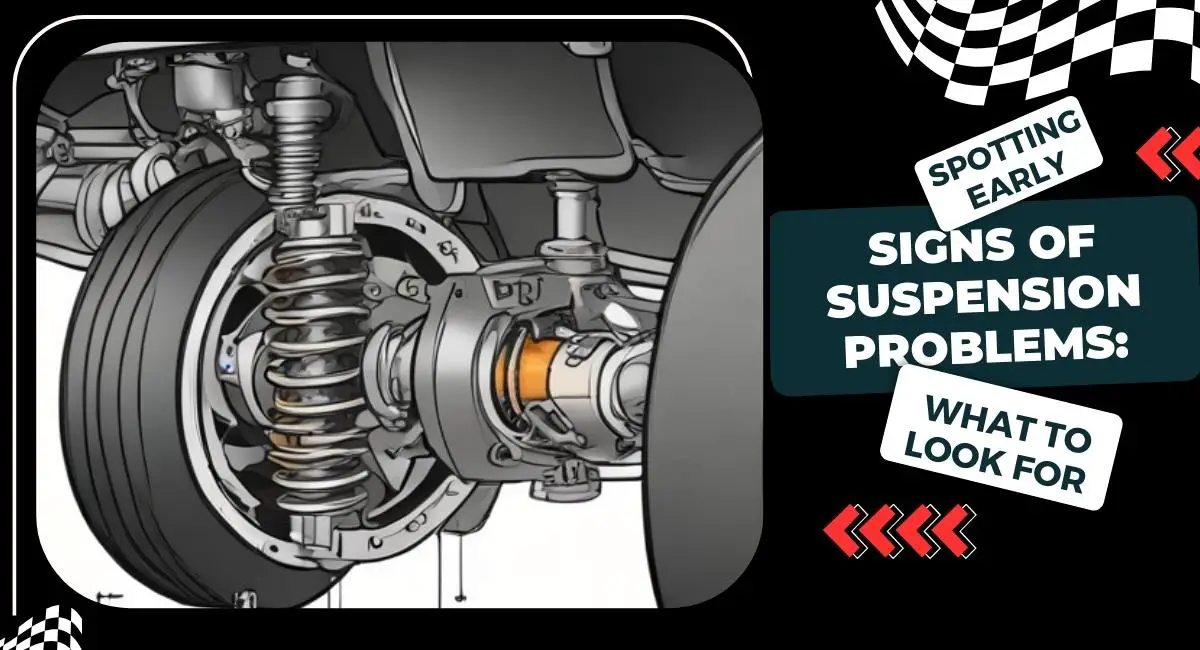According to the New York State Association of Chiefs of Police, 3% of faulty suspension systems contribute to traffic accidents. You may be familiar with instances where you’re bracing for impact as you drive over what seems to be the smallest of potholes. Or you may have noticed your car turning into a makeshift massage chair, vibrating and shaking on slightly uneven roads.
If so, you might be dealing with a distressed car’s suspension system. You’ll find this system beneath the chassis. It is pivotal in ensuring your ride is comfortable and, more importantly, safe and controlled.
However, even superheroes have their Achilles’ heel, and the suspension system is no exception. Our journey today will uncover the early warning signs that your vehicle’s suspension might be sending you, ensuring your carriage doesn’t turn into a pumpkin. Buckle up; it’s going to be an informative ride!
What Are the Early Signs of Suspension Problems?
A survey by the Car Care Council found that a significant percentage of vehicles on the road have some form of suspension problem, with many drivers blissfully unaware until it becomes a significant issue.
Degradation of suspension systems can be silent but deadly, leading to increased stopping distances, poor handling, and, in extreme cases, complete system failure.
Well, before I scare you some more, what is the suspension system made of? The system comprises springs, shock absorbers (or struts in some vehicles), control arms, ball joints, and other components that work harmoniously to provide stability and comfort, like tires.
Now, what is the earliest sign of a car suspension problem?

1. Excessive Bouncing or Vibration
Are you always on a bumpy ride, even when the road seems smooth? In my case, this is the first sign that something is wrong! As shocks and struts wear down or deteriorate with time, your suspension loses its ability to cushion the impact between your vehicle and the road surface.
Besides, a car that continuously bounces after going over a bump or vibrates while driving exhibits classic signs of suspension issues. This excessive movement suggests that the shock absorbers or struts, which are responsible for damping the oscillations of the springs, are worn out.
2. Uneven Tire Wear
One of the most straightforward indicators of a suspension issue is uneven tire wear. Suppose you notice that your tires are wearing down prematurely or unevenly. In that case, it’s a sign that your suspension system might not hold the vehicle evenly, causing unequal tire pressure. This uneven wear can lead to decreased traction and tire failure risk.
Besides, uneven tires are a sign of other issues with the braking system, such as worn-out brake pads. So, as you focus on uneven tires as an issue with the suspension system, look at your braking system.
3. Difficulties in Steering
When your steering feels heavier than usual, particularly at slower speeds, this might indicate that your suspension system is struggling. Properly functioning suspension should make steering effort seamless, ensuring the vehicle responds promptly and accurately to your inputs. Difficulty in steering can decrease driving pleasure and, more importantly, pose a potential safety risk.
4. The Car “Pulls” to One Side
If you constantly battle the steering wheel to keep the car straight, it indicates that something is amiss with the suspension. This pulling can cause additional strain on the suspension components and exacerbate tire wear, leading to further complications.
5. Unusual Noises
Silence is golden unless you’re driving. Squeaks, clunks, and groans emanating from your car when driving over bumps or during turns are cries for help from your suspension system. These noises often indicate that parts of your suspension are worn out and require attention.
If your car’s suspension creaks or squeaks as you exit the vehicle, it’s typically a sign that it needs an inspection. A squeaky suspension can result from insufficient lubrication, damaged springs, or other malfunctioning components.
Considering these signs, let’s explore the causes behind suspension problems and how to mitigate them through preventive measures and maintenance in the following sections.
Causes of Suspension Problems
Understanding the root causes of suspension issues is crucial in preventing them. While some factors are beyond our control, knowing them can help us minimize their impact.
Wear and Tear
Like all mechanical components, parts of the suspension system wear out over time. Springs can lose their tension, shock absorbers leak and lose effectiveness, and bushings wear down, increasing movement and noise. Regular wear and tear is inevitable, but proper maintenance and timely replacements can mitigate the effects.
Impact Damage
Every time you hit a pothole, curb, or speed bump at speed, you’re not just cursing under your breath; you’re potentially damaging your suspension. The sudden forces applied to the suspension components can cause bending, cracking, or breaking. These impacts can be particularly harmful to shock absorbers and struts, reducing their ability to absorb and dampen road imperfections.
Environmental Factors
The environment is crucial in the longevity of your suspension system. Road salt, used in many regions to combat ice, can accelerate rust and corrosion of suspension components. Similarly, driving on roads with frequent debris or off-road conditions can lead to increased wear or damage.
Preventive Measures and Maintenance
The best defense against suspension problems is a good offense in the form of regular inspections and maintenance. Here’s how you can stay ahead:
Regular Professional Inspections
Regularly checking your vehicle with a professional mechanic can help catch problems before they become significant. During these inspections, mechanics look for signs of wear, leaks, and damage to suspension components. They can also check alignment, which is crucial for even tire wear and proper handling.
DIY Checks and Maintenance
Now, this is where you bring your abilities to use. While professional inspections are essential, there are several things you can do yourself to help maintain your suspension system:
- Visual Inspections: this is the easiest you can do. So, regularly check for signs of wear or damage to suspension components. Look for leaking fluids from shock absorbers or struts, indicating failure.
- Listen for Noises: Be attentive to new or unusual noises when driving, especially over bumps or turning. These can be early signs of suspension issues.
- Tire Checks: Monitor tire pressure and wear. Uneven wear can be a symptom of suspension problems or misalignment.
- Weight Management: Avoid overloading your vehicle. Excessive weight can strain your suspension, leading to premature wear.
Other Methods to Prevent Issues with Car Suspension
Here are more ways to keep your car suspension system in check:
- Timely Repairs: Ignoring suspension issues can lead to more significant problems, including increased tire wear, poor handling, and even safety risks. Addressing problems can save money and ensure your vehicle remains safe and enjoyable.
- Keep Tires Properly Inflated: Proper tire inflation ensures even weight distribution across your vehicle, reducing unnecessary stress on the suspension system. Consistently monitor your tire pressure and align it with the guidelines provided by the manufacturer.
- Ensure Proper Alignment: Regular wheel alignments are crucial for maintaining even tire wear and proper handling. Misalignment puts additional stress on suspension components, leading to wear faster.
- Lubricate Moving Parts: Some suspension parts require regular lubrication to function smoothly. Always check your car’s manual for specific recommendations on lubrication intervals and specifications.
- Avoid Overloading: Each vehicle has a recommended maximum weight capacity. Exceeding this limit puts additional strain on your suspension system, tires, and other components, leading to quicker wear.
- Use Quality Replacement Parts: Opt for high-quality components matching your vehicle’s specifications when parts need replacing. Quality parts are more likely to last longer and perform better, protecting your investment in the long run.
How Frequently Should I Get My Car’s Suspension System Checked?
While the best way to keep your car suspension healthy is to have regular checkups, how often should you get the system checked? Inspecting your car’s suspension system at least once a year or every 12,000 to 15,000 miles, whichever comes first, is wise.
Still, this can vary depending on your vehicle’s make and model, driving habits, the type of car suspension, and the conditions of the roads you typically travel on. If you often drive on rough, uneven roads or frequently carry heavy loads, you should have your suspension checked more regularly.
Additionally, any time you experience symptoms of suspension problems—such as unusual noises, uneven tire wear, handling or steering difficulties, or an overly bumpy ride—it’s wise to get the system inspected promptly, regardless of when your last checkup was.
Regular inspections can help catch issues early, potentially saving you from more pricey repairs down the line and keeping your ride smooth and safe.
Conclusion
Suspension issues, signaled by uneven tire wear, noises, and handling troubles, necessitate early detection and understanding for effective maintenance. Regular professional and DIY inspections and prompt repairs are crucial for prolonging your suspension’s lifespan and maintaining your vehicle’s safety and comfort. Caring for your suspension—the foundation of your car’s smooth operation—ensures a reliable and enjoyable driving experience. Armed with this guide, you should be ready to identify and address suspension problems, keeping your ride as seamless as when it was new.
